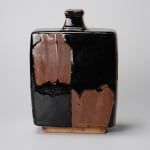Hamada Shoji 濱田庄司 1894-1978
Iron glazed square bottle with finger mark & persimmon under glaze, 1970's
Stoneware
H9 × W6 1/2 × D3 in.
H22.8 × W15.7 × D7.6cm
H22.8 × W15.7 × D7.6cm
With signed wood box
Authenticated by Hamada Shinsaku
Authenticated by Hamada Shinsaku
Sold
Further images
-
(View a larger image of thumbnail 1
)

-
(View a larger image of thumbnail 2
)

-
(View a larger image of thumbnail 3
)

-
(View a larger image of thumbnail 4
)

-
(View a larger image of thumbnail 5
)

-
(View a larger image of thumbnail 6
)

-
(View a larger image of thumbnail 7
)

-
(View a larger image of thumbnail 8
)

-
(View a larger image of thumbnail 9
)

-
(View a larger image of thumbnail 10
)

-
(View a larger image of thumbnail 11
)

-
(View a larger image of thumbnail 12
)

-
(View a larger image of thumbnail 13
)

Hamada Shoji's legacy as a celebrated major figure in the Mingei folk-art movement is enduring. He established the town of Mashiko as a world-renowned pottery center, where he produced functional...
Hamada Shoji's legacy as a celebrated major figure in the Mingei folk-art movement is enduring. He established the town of Mashiko as a world-renowned pottery center, where he produced functional ceramics that showcase simplicity. Hamada was inspired particularly by the folk-craft techniques of ceramics from Okinawa and Korea.
Hamada’s designs convey simplicity and highlight the inherited techniques of craftsmanship in pottery passed down through generations in Japan. For example, he typified the persimmon and iron glazes, while demonstrating the excellence in forms: Bottles, pots, vases, plates.
This bottle shows an iconic form and design of Hamda's: alternating wax resist and dark tenmoku glaze panels with a persimmon underglaze.
Hamada’s designs convey simplicity and highlight the inherited techniques of craftsmanship in pottery passed down through generations in Japan. For example, he typified the persimmon and iron glazes, while demonstrating the excellence in forms: Bottles, pots, vases, plates.
This bottle shows an iconic form and design of Hamda's: alternating wax resist and dark tenmoku glaze panels with a persimmon underglaze.












